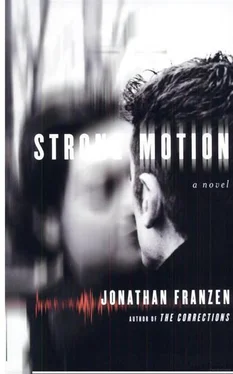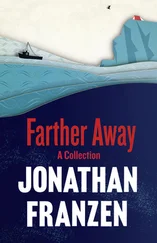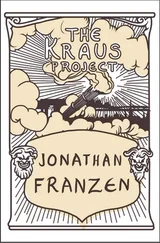Kernaghan was fifty-six years old when he joined Sweeting-Aldren as senior vice president. Those were golden hours for the patriarchy, when every executive in America wore pants with a zipper down the front, and every one of them had a secretary who wore a skirt with a zipper down the side and who, though often more intelligent, was always physically weaker than her boss (her delicate wrists arched over the IBM keyboard), and who sat on a little chair designed to reveal as much as possible of her figure from the greatest number of angles, and who wore a wife’s makeup and cheerful smile and obeyed her man’s orders and spoke in whispers, and the power of so many million heterosexual pairings harnessed by industry made the United States, in the space of a few years, the greatest economic force in the history of the world. Kernaghan’s secretary at Sweeting-Aldren was a veteran named Rita Damiano, a two-time divorcée twenty-odd years his junior. Neither tall nor young nor pretty, Rita hardly corresponded to the ideal woman of Kernaghan’s cheap and single-purpose imagination. Nonetheless she was his regular escort for better than three years, and eventually he even married her, so she must have had him figured out. Must have known that a Catholic manque such as he needed sex to be dirty. Must have known how to scale the affair, keep him off guard, make him commit himself, string out the liberties she allowed him, be coldly disgusted by anal sex on Easter, begging for more of it on Arbor Day, and tight-assed and ultra-efficient the next morning as she served coffee to Aldren Sr. and Sweeting, who with their eyes drew dubious lines between her and Kernaghan, as if to say, “Any interest there?” and Kernaghan coolly shaking his head no. She played a strange, transparent role, letting him know that she thought he was an old lecher and that she tolerated his intimacies only because she wanted money. Because with a man like him, it was wiser not to pretend. It was wiser to be a whore, to be enslaved solely by the promise of his money. She went to Bob and Melanie’s wedding and snubbed Kernaghan’s former in-laws before they could snub her. She drank with him. She sneered at marriage, sneered at pleasure, and by and by Kernaghan became fond of her, and began to cheat on her with the very bimbos whose hypocrisy they’d ridiculed together, and had her transferred to another executive, and that was the end of Rita, at least for the moment.
Meanwhile, thanks again to Kernaghan’s strategic intuitions, the company’s investments in new process technology were paying off. Initially derided by analysts as a high-risk gamble, Sweeting-Aldren’s M Line, a closed-system continuous process capable of producing one hundred tons of any of several chlorinated hydrocarbons per day, was operating at capacity, the U.S. armed forces having discovered hundreds of thousands of square miles of Southeast Asian jungle in urgent need of defoliation. It took the rest of the industry four years to catch up with demand, and in the interim Sweeting-Aldren never saw earnings growth of less than 35 percent annually. Its new G Line, producing spandex for a nation whose appetite for revealing swimsuits, lightweight bras and other clingy items had become insatiable, was going great guns as well. It was Kernaghan who’d persuaded Aldren Sr. to double the G Line’s capacity in 1956, when it was on the drawing board, Kernaghan whose elegant fingers tested the spandex virtues of countless articles of feminine apparel between 1958 and 1969, during which decade the extra G Line capacity earned the company $30 million, minimum, after taxes, all because of him. Add to this the brisk wartime sales of paint and high explosives, the budding market for Sweeting-Aldren’s new Warning Orange pigments, and steady returns on all its more mundane products, and it began to seem a wonder that Kernaghan came out of the sixties worth only six or seven million.
But the company was conservatively managed — looking to the future, holding the line on debt, funneling hefty sums into research and development. The young Anna Krasner, owner of an M.S. in physical chemistry from RPI, was one beneficiary of their scattershot hiring. Kernaghan later said he’d already picked her out in the parking-lot crowd on her first day of work. But neither of them liked to talk about those early days; they became silent and looked a little ill when the subject arose; and Bob found this curious, at least in Kernaghan’s case, because a victorious male so often enjoys reminding his lover how she couldn’t stand the sight of him at first. Maybe the sting of her rejection was still too fresh in his mind, or maybe he wasn’t so sure he was victorious, or maybe he was uneasy about the price he’d had to pay to change her mind.
In any case, Rita would have been watching. She would have known, firsthand or through the grapevine, that Kernaghan was smitten with the pretty new chemist in Research and that the chemist was flamboyantly crushing his initiatives, sticking the long-stemmed roses in Erlenmeyer flasks with reagent-grade sulfuric acid, feeding the Swiss chocolate truffles to albino rats. On an errand for her new boss, Rita drops into Kernaghan’s office and says, “Didn’t you know? You reach an age where you’re only hideous to a thing like her. Where she looks at you and all she can think is prostate problems.”
Let loose in her own lab with a fat budget, Anna takes the company at its word when it tells her no idea is too wacky to pursue. She reads some imaginative accounts of the origin of the solar system, cooks water and ammonia and free-state carbon in a high-pressure oven, and strikes oil. She happens to be the kind of person who’ll face hungry lions in a coliseum before she’ll admit she’s mistaken. She believes there’s a zillion gallons of oil and a godzillion cubic meters of natural gas inside the earth, beginning at a depth of about four miles, and no anvil-headed senior research chemist with a crew cut and stinky breath is going to tell her it isn’t so. She goes straight to the nearest vice president, young Mr. Tabscott, and says, “We drill for oil in Berkshires!”
Mr. Tabscott, more susceptible to good looks than the anvilheaded senior research chemist, says, “We’ll take this under serious advisement, Anna, but maybe in the meantime you should reinvest your energies in some totally new direction, give yourself a well-deserved rest from this very interesting and speculative research you’ve done.”
He’s still chuckling and shaking his head when the single-minded Anna begins to write the paper that eventually appears in the Bulletin of the Geological Society of America , and Jack Kernaghan gets wind of her difficulties. He steals into her lab, looks over her shoulder at the orthographic atrocities she’s committing in her notebook, and says, “You’re pretty stupid if you think we’re going to drill a four-mile hole through granite for you.”
She doesn’t look up. “They’ll do it.”
“Not a chance, girlie.”
“No?” She raises her eyes from the notebook to the periodic chart in front of her. She flares her nostrils. “Then it’s because you stopped them. And if they do drill, it’s because they like me better than you.”
He considers the flasks holding his blackened roses and their exploded stems. “Tabscott was just humoring you,” he says. “He’s going to let this thing die. When he does, you go and see him and ask him if I had anything to do with it. And then before you do anything rash, you come and see me.”
Anna tosses her lovely hair from one shoulder to the other and goes on writing. But it happens just as Kernaghan said it would. Various sober scientists are consulted and agree that her theory is 99.9-percent-probably hogwash, Tabscott tells her the company won’t spend $5 million on a one-in-a-thousand chance, and Anna says, “I quit! This is good theory .”
Читать дальше
Конец ознакомительного отрывка
Купить книгу












